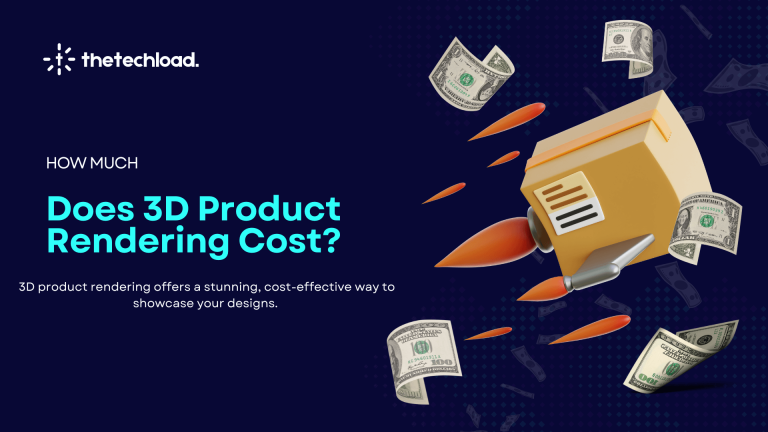Did you know that 82% of shoppers are more likely to engage with 3D product rendering than with static images? Customers prefer the ability to zoom, rotate, and explore products from every angle in real-time. This interactive experience builds trust and enhances their decision-making process.
For Amazon sellers, standing out in a sea of competitors is crucial. Static images often fail to showcase a product’s full potential, leaving buyers uncertain. 3D product rendering solves this by offering a dynamic presentation that highlights every detail of your product.
This article shows how 3D product rendering can elevate your listings, drive customer engagement, and boost conversion rates. Ready to transform your product pages? Let’s dive in.
What Is 3D Product Rendering?
3D product rendering, also often referred to as product 3D visualization, involves creating hyper-realistic or non-photorealistic images from 3D models using specialized software. The outcome of this process is known as a 3D render.
These incredibly detailed renders offer a full 360-degree view of the product, allowing potential buyers to visualize it as if it were physically in front of them.
This enhances the customer’s understanding of the product’s form and function, ultimately contributing to their purchase decision.
How to Implement 3D Product Rendering for Your Amazon Products
Implementing 3D product rendering for your Amazon products can be a game-changer for your business. Here’s a step-by-step guide on how to do it:
1. Identify Applicable Products
Begin by selecting products that would benefit most from enhanced visualization. Products with intricate designs, such as electronics, furniture, or jewelry, are ideal for 3D rendering as they allow customers to examine every detail.
Similarly, items available in various colors, sizes, or configurations—like accessories, home décor, or customizable goods—can use 3D renders to display these variations effectively.
If your product relies on showcasing functionality, like gadgets with moving parts or items requiring assembly, 3D rendering provides an interactive way for customers to understand its features.
Focusing on such products ensures that your investment in Amazon 3D product rendering delivers maximum impact.
2. Choose a 3D Rendering Service
Finding an exemplary 3D rendering service is essential for creating high-quality, realistic visuals that enhance your Amazon listings. With so many options available, it’s important to choose a service that aligns with your product complexity, branding needs, and budget.
What to Look for in a 3D Product Rendering Service:
✅ High-Quality Renders – Ensure your product is displayed with accuracy, realistic textures, and proper lighting.
✅ Customization & Flexibility—Look for services that customize visuals to match your branding and highlight unique product features.
✅ Fast Turnaround Times – Speed matters. A good service delivers high-quality renders without long delays.
✅ Cost-Effective Solutions – While premium services offer better quality, ensure the investment aligns with your product’s price point and profit margins.
✅ Expert Guidance – A professional team can help you optimize your 3D visuals for maximum engagement and conversions.
At The Tecload, we specialize in creating photorealistic 3D renders designed to increase product visibility, build trust, and boost conversions.
Our team combines technical expertise with creative insights to showcase your products most compellingly.
3. Provide Product Information
Once you’ve chosen a service, you must provide them with comprehensive product information. This typically includes specific product dimensions, the materials from which it’s made, and available color options.
Additional details like product functionality, unique features, and significant design elements may also be vital to creating the most accurate and attractive 3D renders.
4. Create 3D Renders
After providing all necessary product information, the 3D rendering service will create a 3D model of your product. Creating 3D renders is a detailed process that digitally brings your product to life, ensuring accuracy and visual appeal.
Here’s how it works:
- Designers use advanced 3D modeling software, like Blender or Maya, to create a virtual replica of your product. Every curve, edge, and component is designed to match the actual product precisely.
- Realistic textures like fabric patterns, wood grains, or metallic finishes are added to enhance the model’s authenticity.
- Proper lighting setups, including shadows and highlights, are incorporated to create depth and visually engage the render.
- Interactive features, like 360-degree views or zoom options, are developed to allow customers to explore the product from all angles.
- Multiple configurations, such as color options, usage scenarios, or disassembled views, are created to understand the product comprehensively.
5. Uploading 3D Renders to Amazon
To showcase your product effectively, upload your 3D renders using Amazon’s 3D Asset Upload Tool in Seller Central. These interactive visuals, such as 360-degree views and zoom features, offer an immersive experience, helping customers make confident purchasing decisions.
Steps to Upload 3D Models:
- Log into Seller Central and navigate to Catalog > Upload Images.
- Open the Image Manager and locate the product listing.
- Click the 3D Model tab on the right side of the page.
- Select Upload 3D Model and follow Amazon’s 3D model submission guidelines.
- Submit your content for approval.
Once approved, your 3D render will elevate the product’s visual appeal, helping customers better understand it.
How Can 3D Product Rendering Improve Amazon Listing Conversion Rates?
3D product rendering can give you the competitive advantage required in the fiercely competitive Amazon market. In online sales, 3D visuals aren’t just about aesthetic appeal; they influence purchase decisions and improve listing conversion rates.
3D renders can significantly impact your Amazon conversion rates, from capturing customer attention to providing comprehensive product understanding. Now, let’s dive into how 3D visuals can transform how customers perceive your product, affecting conversions.
1. Enhanced Product Visualization
Unlike traditional product images that are flat and two-dimensional, 3D renders offer a realistic representation of your product. This allows customers to accurately understand the product’s size, shape, texture, and color. They can also see the product’s appearance from various angles without physically holding it.
With enhanced visualization, customers can make more informed purchasing decisions, reducing the chances of returns and negative reviews.
2. Increased Perceived Value
High-quality and professionally rendered images can significantly increase the perceived value of your product. 3D renders create a premium look that separates your product, making it appear more desirable to potential buyers.
This increased perceived value can lead to higher conversion rates, as customers are willing to pay more for a product that looks worth the price.
3. Improved Brand Reputation
First impressions matter, especially in the world of e-commerce. By using 3D renders on your Amazon listings, you show customers that you have invested time and effort into creating a professional and visually appealing product page.
This can improve your brand’s reputation, instill trust and confidence in potential buyers, and lead to increased conversions.
4. Ability to Showcase Product Variations
With traditional product photography, it can be challenging to showcase different color or size variations of a product without physically photographing each one. However, with 3D rendering, you can easily create multiple product variations, giving customers a better understanding of their options.
This can increase sales, as customers are more likely to purchase a product with a clear picture of its appearance in different variations.
5. Cost and Time Efficiency
Producing high-quality traditional product photoshoots can be expensive and time-consuming. However, 3D rendering can save time and money by creating hyper-realistic images without multiple photoshoots.
This allows you to showcase your products more efficiently and quickly and make changes or updates to your product listings without incurring additional costs.
6. Faster Adaptability to Market Trends
Traditional product photography limits editing and creativity. In a fast-changing market, sellers must stay agile and responsive to evolving demographics and customer preferences.
Product listings need periodic updates to avoid becoming generic in a saturated marketplace. 3D rendering simplifies this process.
Once you’ve acquired the product renders, you can utilize them in the future, enhancing your ability to generate new images promptly in response to emerging product trends.
This nimbleness in adapting to market trends, facilitated by 3D rendering, can ultimately lead to increased conversions and sales.
3D Product Rendering vs. Product Photography: Which One is Right for You?
3D product rendering and photography have advantages, but choosing the right one depends on your product type, budget, and marketing goals. Below is a comparison to help you decide:
| Feature | 3D Product Rendering | Product Photography |
| Cost | More cost-effective for multiple variations & long-term use | Expensive, especially for high-end shoots & multiple angles |
| Scalability | Easily scalable for different backgrounds, lighting, and textures | Requires separate shoots for different versions |
| Customization | Full control over lighting, textures, and angles | Limited to real-world lighting and environment |
| Accuracy | Ideal for detailed, technical, or conceptual products | Best for capturing natural textures and real-world appearance |
| Turnaround Time | Faster for bulk product variations | Can take longer, especially with professional setups |
| Consistency | Ensures uniform product images across listings | May vary due to lighting, angles, or photographer style |
| Suitability | Great for electronics, accessories, industrial parts, and concept products | Best for clothing, food, and handmade or artisanal products |
| Revisions | Easy to modify and update | Requires a reshoot for changes |
| Engagement | Allows 360° views and interactive elements | Limited to static images |
Conclusion
In today’s competitive e-commerce landscape, 3D product rendering is no longer just an add-on; it’s a necessity. With 82% of shoppers engaging more with interactive 3D views, it’s clear that this technology can significantly enhance customer experience, reduce uncertainty, and drive higher conversion rates.
By offering a dynamic, immersive product experience, 3D rendering builds trust and helps your listings stand out. It’s not just about showing your product; it’s about creating a visual story that resonates with your audience.
At The Tech Load, we help Amazon sellers harness cutting-edge solutions like 3D product rendering to transform their listings and maximize sales. Ready to take your product presentation to the next level? Let The Tech Load guide your success.
What is Amazon 3D Product Rendering: FAQs
There are two types of 3D rendering: 3D Real-Time Rendering, which generates images instantly for interactive uses like video games, and 3D Post-Process Rendering, which involves refining renders after creation to enhance quality and details.
The key difference between 2D and 3D rendering lies in dimension. 2D rendering creates flat images without depth, showing only a single perspective, while 3D rendering produces lifelike, three-dimensional visuals that can be rotated and viewed from multiple angles.
3D modeling and 3D rendering are interconnected stages in creating 3D graphics. Modeling constructs objects using geometric shapes in a 3D space while rendering generates lifelike images from the 3D model using textures, lights, and colors.





One Response